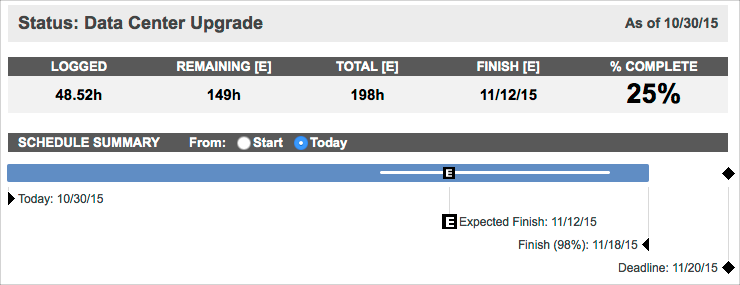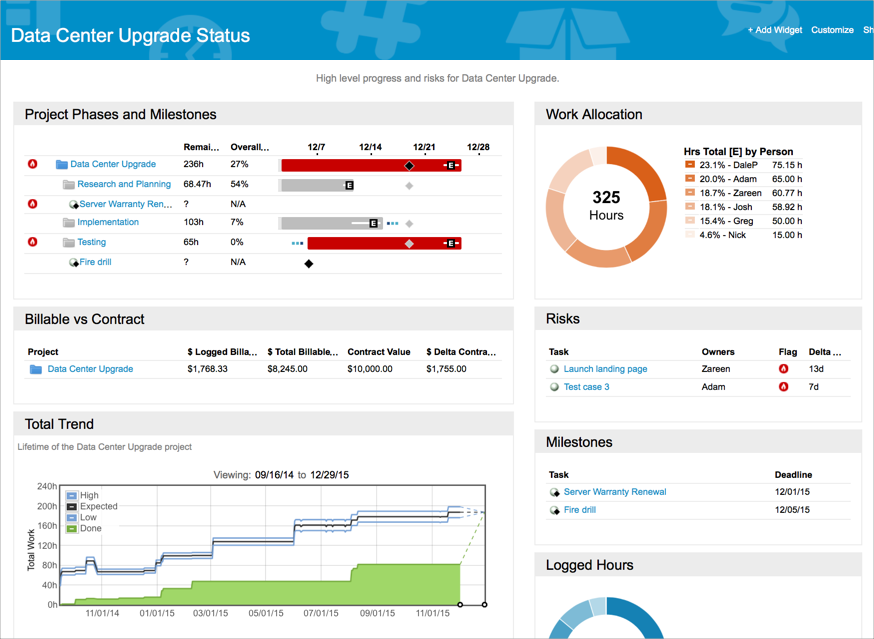
Department VP: “Can you give me an update on the Greenfields Project? Is it on plan?”
Project Manager: *tosses coin* “It’s heads – we’re doing fine.”
Department VP: “Don’t you have a more scientific method?”
Project Manager: “Best out of three?”
As a project manager, sometimes you need to see what’s happening across your entire portfolio and other times you need a real-time view of a single project. LiquidPlanner gives you the information you need to successfully monitor and report on the health of your project.
Use the Timeline View
Why you need it
The Timeline View, which shows you a dynamic Gantt chart, is one of the most popular methods for project managers to view schedules. It gives you the choice of real-time visibility into what’s happening across your entire portfolio, or you can get insights for a specific initiative or product line. At a glance, you’ll know whether your near-term and long-term projects are going according to plan.
How to use it
The Timeline View is the default setting when you’re on the Projects tab. All you have to do is find your particular project, and look at the corresponding schedule bar to the right. The bar shows you the amount of work remaining and the date range over which the work will take place. Make sure that you have a deadline date set on the project so that LiquidPlanner will be able to tell you whether or not you’re on schedule.

Once you set your deadline, if the project’s schedule bar is blue, then you can expect to finish your work before your deadline date. In other words, good news, your project will be delivered on time!
How to share it
You can use a PDF Snapshot to share a view of the project’s timeline with stakeholders. These snapshots will capture a specific aspect of the plan along with the schedule bars. Alternatively, you can add a Projects View widget to a dashboard that you share with workspace members or external customers or clients.
Use the Project Status Report
Why you need it
Running a Status Report for a project will instantly show you the most vital details including hours logged, hours remaining, percent complete, tasks, milestones, deadlines, totals by person, and provide a handy schedule summary at the top.
How to use it
On the Projects tab, select a project, click the View Menu, and choose Status. See the Project Status Report article for more details.

How to share it
Click the printer icon in the upper right of the report and use your browser function to save as a PDF.
Build a Status Dashboard
Why you need it
One of the most frequent uses of a dashboard is to create a curated view that shows you the health of a single project. You might create a status dashboard specifically for your project team to consolidate the nitty-gritty details and collaboration content. Or, to get a 10,000 foot view, you might build a status dashboard for your stakeholders that shows a high-level overview of progress, trends, and risks for the project.

How to use it
Start by thinking about your audience and then building your dashboard to present the most important information for those viewers.
- On the Dashboards tab, click + Dashboards.
- Give your dashboard a title, like “Apollo Project Status.”
- Click + Widget.
The following widgets are helpful to have on a status dashboard:
- Projects View – filtered to a single project
- Analytics Table – filtered to a single project, showing tasks that are flagged (have risk alerts), milestones by date, or current/expected billable amounts
- Donut Chart – filtered to a single project, showing Hrs Remaining [E] by task, person, or for the overall project
See the Dashboards Gallery for another example of a status dashboard and Dashboard Widgets for more information about each of the above widget types.
How to share it
Once you have built your status dashboard, you can share it with other workspace members and external guests. You can invite them to view your dashboard by clicking the Share link. Once you provide access, viewers can see the current status of your project at any time. See the Dashboards article for full details.

